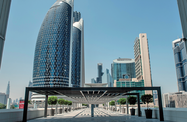The emirate’s economy continued its recovery in 2012, with a number of key sectors posting high growth over the past 12 months. However, there are some concerns that the rebound could happen too quickly, resulting in further difficulties in the future.
At the end of November, the Dubai Statistics Centre (DSC) issued data on the economy’s performance for the first half of the year, showing that GDP had risen by 4.1% to $44bn. Much of this expansion was due to strong results from the tourism sector, which posted 13% growth in 2012 on the back of occupancy rates topping 80%, as well as increased trade, retail and transport figures.
One sector that continues to see a slow recovery is real estate, with various private sector reports putting the growth of real estate prices through 2012 at between 7% and 19%, depending on location and project size. This recovery will likely continue to be gradual and only in certain specific areas, as the market has to absorb up to 36,000 new residential units over the next three years and more than 2m sq metres of office space by the end of 2014, according to CB Richard Ellis.
These figures are likely to be swollen by a series of new projects announced in the fourth quarter of 2012. Dubai officials have announced a series of mega property developments, such as a $2.7m leisure and theme park complex and a large satellite city to be named Mohammed bin Rashid that will be home to the world’s largest shopping mall, a theme park and more than 100 hotels.
However, ratings agency Moody’s has expressed concerns regarding the financial resilience of Dubai’s economy. Moody’s downgraded a number of financial institutions due to high levels of non-performing loans, which represented between 15% and 17% of total bank loans. The agency cited pressures related to asset quality, stemming from the economic downturn. The downgrade was in contrast to risk perceptions from other analysts following successful debt restructuring by Dubai and its related companies.
The agency also said that continued exposure to large, government-related issuers and legacy corporate impairments – primarily real-estate-related – would keep loan levels high this year and beyond. While Dubai officials have said the funding for the new projects announced in late 2012 would be sourced locally, the emirate’s banks be careful not to further expose themselves to increased debt risks, with this caution in turn potentially making it more difficult to raise the capital required for the projects.
To reduce banks’ exposure to the risks in lending to government-related entities and emirate governments, the UAE Central Bank has plans to implement a new cap on lending to these entities. The implementation of these changes, however, has been postponed pending a review, media reported in early January. Aimed at partly addressing concerns over concentration risks, the new rule, first announced in April 2012 by the Central Bank, specifies that a bank’s aggregate lending to the local governments of the UAE and their non-commercial entities cannot exceed 100% of the bank’s capital base, while individual borrowers are limited to 25%.
Over the next four years, Dubai will have to repay or renegotiate $50bn worth of debt, with $9.4bn-$9.8bn of this expected in 2013. Any delays in servicing this debt could undermine the confidence that has slowly been restored over the past two years and raise concerns over the sustainability of short-term recovery.
While Dubai has proved itself resilient to any negative impact from the Arab Spring, and indeed appears to have benefitted as many firms have moved their operations to a more stable environment, it is less immune to a further downturn in the global economy. Solid growth will be necessary to fund the emirate’s new development programmes and service its debts. Should the crisis in Europe prove contagious in 2013, Dubai’s economy could feel the ripple effect, if only through falling tourism receipts and a drop-off in trade.
It will be some time before government agencies release total economic data for 2012, though on December 8 the Ministry of Economy predicted that Dubai would achieve 4% growth in 2012. While some estimates suggest that 2013 may see slower expansion, with Bank of America Merrill Lynch, a financial services and advisory firm, warning the UAE’s economy as a whole could see growth of a more modest 3.4% next year, Dubai has outperformed most forecasts in 2012 and may well do so again in the coming 12 months.

